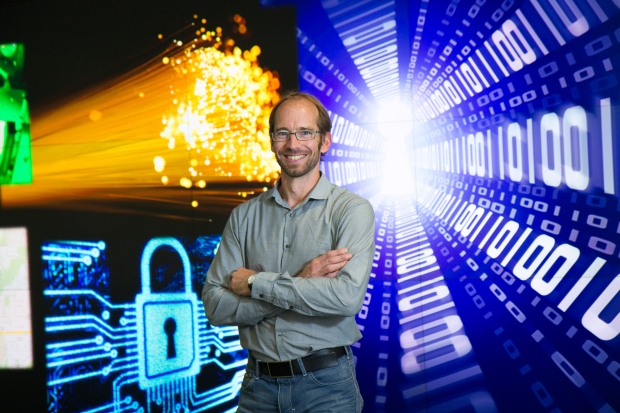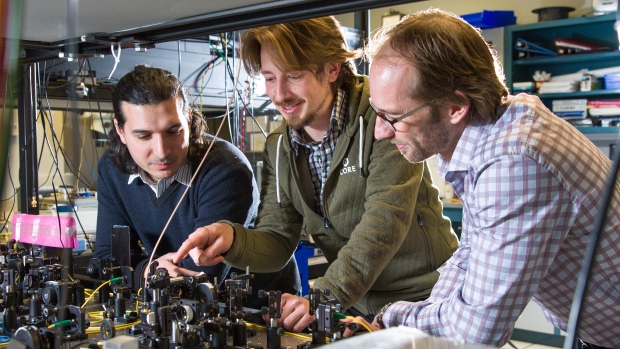In a "major step" toward practical quantum networking, researchers at the University of Calgary have successfully demonstrated the teleportation of a light particle's properties between their lab and the city's downtown area, six kilometres away.
"What is remarkable about this is that this information transfer happens in what we call a disembodied manner," said physics professor Wolfgang Tittel, whose team's work was published this week in the journal Nature Photonics.
"Our transfer happens without any need for an object to move between these two particles."
Their research relies on advanced lasers, a dedicated fibre-optic line, and light-detecting sensors that must be kept incredibly cold because they won't work at temperatures above –272 C.
It also relies on the increasingly well-known but still baffling phenomenon of quantum entanglement.
The concept is so bizarre that a dubious Albert Einstein famously dubbed it "spooky action at a distance" in the 1940s, as he described what he saw as flaws in the emerging theory of quantum mechanics.
But today, an increasing body of evidence has confirmed the most counterintuitive predictions of quantum theory, including the strange behaviour of "entangled" particles.
These are pairs of particles that are fundamentally linked, such that the properties of each one is intrinsically tied up in the other and actions affecting one particle have an immediate effect on the other, no matter how far apart the particles are.

Wolfgang Tittel, professor of physics and astronomy at the University of Calgary, and a group of PhD students have practically demonstrated how to transfer quantum states of photons over a distance of more than six kilometres. (Riley Brandt/University of Calgary)
For their demonstration, the U of C team used a specialized laser to create a pair of entangled photons — elementary particles of light — and sent one to Calgary City Hall via a dedicated fibre-optic line while keeping the other in their lab at the university in the city's northwest.
At the same time, a third photon was sent to city hall from another location (a data centre in the southeast community of Manchester) so that it would meet and interact with the entangled photon.
"We had to make sure it arrived at the same time at city hall as the photon that was created at the data centre," said Tittel.
"And that's pretty tricky, because 'the same' in our case means with a provision of a few picoseconds."
(For the non-physics crowd: A picosecond is one-trillionth of a second, or 0.000000000001 seconds — which means not much room for error.)
Tittel said the team had to create feedback mechanisms in the experimental setup to ensure "very precise timing" of the photons' arrivals at city hall, as small changes in outdoor temperature that cause the fibre-optic cables to expand or contract by minuscule amounts could throw off the timing.
Success from kilometres away
In the end, though, the system worked and the transfer of properties between the photon at city hall and the photon at the university — 6.2 kilometres away, as the crow flies — was confirmed.
"It's fascinating to see that, not only teleportation exists, but that you can … transfer the state without transferring the photon over a large distance," Tittel said.
"From a fundamental point of view, that is fascinating. From a practical point of view, we used a standard fibre network to do so, which of course moves this whole demonstration into the realm of something that will be practical and useful."
The team's article in Nature Photonics says the demonstration "constitutes a milestone towards a global quantum internet," as it is one of the longest distances over which quantum teleportation has been achieved using a fibre-optic network in this way.
"The way we localized all the different stations within the city of Calgary reflects what needs to be done in a future quantum repeater that will allow us to send quantum information, in principle, over arbitrarily long distances," Tittel said.
"So, it's a major step forward toward that goal."
Coincidentally, in the same edition of the same journal, an independent team of Chinese researchers published the results of their own demonstration — one that used a slightly different setup but employed the same principles and confirmed quantum teleportation using a fibre-optic network over a span of 12 kilometres.
"Our experiment marks a critical step towards the realization of a global 'quantum internet' in the real world," the Chinese team wrote.
What is the 'quantum internet,' anyway?
It doesn't exist yet, but the dream of a "quantum internet" involves taking advantage of a key element of quantum mechanics — the fact that observing a particle's quantum state changes that particle's quantum state.
This creates the opportunity to communicate with a degree of security never before possible, because no one can intercept a communication without the intended receiver of the information knowing about it.
"If you encode keys into quantum states and send them from person to another — for instance, through teleportation — then it turns out that you can verify at the receiver's side … if an eavesdropper has acquired any information about that key," Tittel said.
"If you find out that nobody has tampered with this transmission, you know that you share a perfectly secure key and then you can use it to encrypt some sensitive data."
Partnership between university, municipality
The development of functional quantum networks is still a long time off, but Sylvain Mayer, an information architecture engineer with the City of Calgary, said the city plans to continue working with the university to speed up the process.
The fibre-optic network the U of C team used normally carries information between various city departments, but a dedicated portion of it was made available to the researchers through the Urban Alliance, a partnership developed in 2007.
"We're happy that part of our fibre infrastructure can be used by these fellows to be able to research cutting-edge technology," Mayer said.
"The city just wants to be able to continue to be able to help educational institutions in their pursuit of next-generation types of services that will eventually be able to help everyone around the world."
- MORE CALGARY NEWS | Snow arrives early west of Calgary in Banff, Lake Louise areas
- MORE CALGARY NEWS | 'Extremely lucky' no one died in C-Train derailment, says Calgary Transit




























